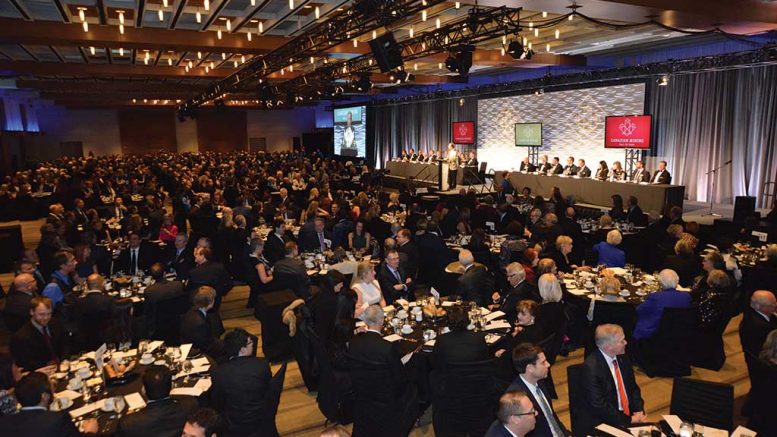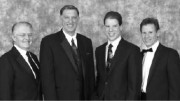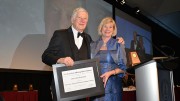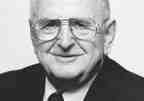The Canadian Mining Hall of Fame (CMHF) bestowed honours on five industry giants at its thirty-first annual induction ceremony in January at the Metro Toronto Convention Centre. The 2019 inductees — Kate Carmack, James M. Franklin, James W. Gill, A. M. (Sandy) Laird and Brian K. G. Meikle — join 176 existing CMHF members.
“Tonight we celebrate the lives of four men and one exceptional woman who through their passion, commitment and dedication have made a huge difference to our industry,” said master of ceremonies Pierre Lassonde in his opening remarks.
Kate Carmack
The first inductee of the evening was Kate Carmack (1857–1920) — or Shaaw Tlaa, in her native language — prospector George Carmack’s wife, who became only the third woman, and the first Indigenous woman inducted into the Canadian Mining Hall of Fame. (Viola MacMillan and Kate Rice are the other two women.) Carmack, her husband and her Tagish First Nation relatives made the first gold discovery at Yukon’s Rabbit Creek on Aug. 17, 1896. Rabbit Creek was later renamed Bonanza Creek, and the discovery spurred the famed Yukon gold rush.
Within the pantheon of Canadian Mining Hall of Fame inductees, Kate Carmack now joins the “Klondike Discoverers” group, whose other members are American adventurer George Carmack (1860–1922); Canadian prospector Robert Henderson (1857–1933); Kate’s brother Skookum Jim Mason (Keish) (1859–1916); and her nephew Dawson Charlie (Kaa Goox) (1865–1908) — all four of whom were inducted in 1999.

Louise Grondin (left), Agnico Eagle Mines senior vice-president of environment, sustainable development and people and CMHF director, presenting to Zena McLeod, great grand-niece of Kate Carmack. Photo by Keith Houghton.
Accounts vary as to who made the initial discovery. Some credit George Carmack, while others credit Skookum Jim Mason. Though no claims were ever registered in Kate Carmack’s name, historians now consider her knowledge of the land instrumental in the beginnings of the Yukon gold rush. Some speculate she may have made the first gold discovery at Rabbit Creek herself.
Kate Carmack’s great grandniece Zena McLean accepted the award on her behalf, taking the stage to a traditional song performed by McLean’s daughter and her cousin’s daughter.
McLean used the opportunity to recount a story she had heard from her great grandfather — Kate’s nephew — who was also at Rabbit Creek in 1896.
“One story he shares,” McLean said, “is of George musing, ‘My little wife Kate will make me a rich man someday by bringing me nuggets from all the gold she has found washing in her wash water.’ And man, did she ever clean up.”
The Carmacks would later move with their daughter, Graphie, to California to live with George’s sister. There, George Carmack abandoned his family, and married another woman in Washington. Kate Carmack and Graphie would eventually move back to Kate’s home of Carcross, Yukon, with Kate living the rest of her life with little money.
“Kate was not just overlooked in history, she was miswritten into history,” said Deb Vanasse, author of Wealth woman: Kate Carmack and the Klondike race for gold during a Kate Carmack tribute video played at the event. “If it weren’t for her, the Klondike discovery wouldn’t have happened in the way that it did.
“George, her husband, kept everything in her lifetime, but she came home to her true wealth, which was her culture and her stories.”
Brian Meikle
Next, Brian Meikle was inducted for his many mineral discoveries and developments, including three major deposits he helped discover or expand, and progress into operating gold mines: Camflo in Quebec, Mercur in Utah, and the fabulous Goldstrike gold mine in Nevada, which powered Barrick Gold to become the world’s largest gold miner.
Born in Montreal, Meikle completed his M.Sc. in geology at McGill University in 1955, followed by his PhD in geology in 1959. He received McGill’s Logan Gold Medal in 1958 for top marks in geology.
“Brian was a modest person, but a super geologist with a fantastic record for developing mines,” said Ed Thompson, a 2018 CMHF inductee, in a tribute video.

Lisa McDonald (left), PDAC executive director, presenting to Janet Meikle (widow of Brian Meikle). Photo by Keith Houghton.
“I didn’t even know he had a doctorate in geology until years later, so it wasn’t something he bragged about at all,” added Larry Kornze, retired Barrick exploration manager, in the video. “Just a very kind person.”
Meikle started his career as a secondary school teacher, but soon became a geologist. His first major discovery was Camflo, which operated from 1963 to 1992, and produced 1.9 million oz. gold. Meikle spent 22 years at Camflo spanning many roles, from geologist to mine manager, and vice-president of operations. He was involved in Barrick’s deal to buy Camflo in 1984, as well as its 1985 acquisition of Mercur, which would produce 2.5 million oz. gold from 1985–1995.
His largest contribution to Barrick came in 1986, when he encouraged the company to acquire an interest in Goldstrike, theorizing that its known shallow oxide mineralization was the tip of a much larger system. His hunch paid off when the first hole beneath Goldstrike’s Post deposit cut 119 metres of high-grade gold, followed by a hole that cut 189 metres of 10.3 grams gold per tonne.
Exploration led by Meikle later showed that Post was part of a larger deposit that became known as Betze-Post. Goldstrike would grow to 60 million oz. gold in reserves and resources across several deposits, and rank as North America’s largest gold mine and the world’s second largest.
In 1996, Barrick opened the Meikle underground gold mine at the Goldstrike property, naming it in tribute to the company’s star geologist.
Keith Bettles, former chief geologist and exploration manager at Barrick Gold, said in the video that Meikle was “always very optimistic and positive, which is important for an exploration geologist.”
Meikle died in 2016 at age 84, and his widow Janet Meikle accepted the award on his behalf.
“I am honoured to accept this award,” she said. “Brian and I had 58 memorable years together. This is a momentous occasion — congratulations, inductees.”
James M. Franklin
Born in North Bay, Ont., in 1942, Franklin earned B.Sc. (1964) and M.Sc. (1967) degrees from Carleton University, and his PhD (1970) from the University of Western Ontario. He joined the Geological Survey of Canada (GSC) in 1975, after a six-year term as the first professor of economic geology at Lakehead University.
The CMHF describes Franklin as a “distinguished geoscientist who helped build and advance the knowledge base of Canada’s mineral industry,” who spent much of his career with the GSC “documenting the complex evolution of the Canadian Shield, and the link to its phenomenal mineral wealth.”
He was a pioneer in the development of models and techniques to guide exploration for volcanogenic massive sulphide (VMS) deposits, and he led ocean-based research of “black smoker” systems to understand how VMS deposits form, as one of the first geologists to use ocean-going submersibles to study black smokers first-hand.

Jon Baird (left), SEMP Consulting principal and CMHF chair, presenting to James Franklin. Photo by Keith Houghton.
Franklin has also served as a geological consultant, educator, author, lecturer and industry ambassador, and awards for his achievements, include the RAF Penrose Gold Medal from the Society of Economic Geologists and the Logan Gold Medal from the Geological Association of Canada.
Franklin started out university life in electrical engineering, but said in his tribute video: “It was the age of Sputnik, and I thought this was a pretty cool thing to do. And I met a guy in residence who was a geologist and spent his summers out in canoes and things, and it sounded much more fun than sitting in an office wearing a tie, so I moved into geology and never regretted it.”
As Franklin accepted his award in person, he told the audience that his initial move to the GSC was a key moment of his career: “Quite frankly, they created the job of my dreams for me. They created a position called ‘Regional Metallogenist for the Southern Canadian Shield’ — which was kind of the 007 of geology. I could do pretty much what I wanted.”
Franklin said his success “is entirely due to the people with whom I’ve worked over the last 50 years. I’ve worked in research, teaching and exploration, and without the exceptional insight of senior managers of the Geological Survey — I can name Digby McLaren, Ray Price and Chris Findlay — I might never have received the opportunity to expand my horizons to understand ore deposits throughout the Canadian Shield, and in particular to do the marine minerals project, which I never had the faintest idea I’d get involved in doing, but was an enormous opportunity.
“Innumerable mining companies have opened their doors to me, and gave me data. It’s one of the great things about the Canadian mining industry, that they would do this, without any question whatsoever.
In closing, Franklin thanked his wife Claire and daughter Meredith, “who provided me with outstanding support, significant direction and a lot of laughs. Claire and I have been married 50 years, but she says it’s only been 25, because I was away the other half. And she’s probably right — that’s the story for most of us, and it’s been absolutely wonderful.”
A.M. (Sandy) Laird
Born in 1934 in Invermere, B.C., and growing up on a farm, Laird originally thought his future livelihood would involve horses, but working for the first time in a small mine near his home at age 16 introduced him to what would become his career.
Laird spent several summers as an underground miner and a geologist assistant before graduating from the University of British Columbia with a BASc in mining engineering in 1957.
During a 39-year career with global mining major Placer Dome and predecessor Placer Development, Laird was directly involved in transforming at least 15 mineral projects into profitable mines.

Hatch senior advisor and CMHF director Chris Twigge-Molecey (left) presenting to Sandy Laird. Photo by Keith Houghton.
He headed the company’s project development group from 1988 to 1995, and was later responsible for Placer Dome’s global operating and development subsidiaries, with the CMHF noting that “many of the mines were large, technically complex, and in challenging jurisdictions.”
Alf Hills, former vice-president of evaluations at Placer Dome, said in a tribute video that “what Sandy brought to the industry was the value that good engineering, good operations does to make a successful project, both in terms of turning them into mines and running them. He represents a class of people who turn dreams into reality.
“Sandy basically became Placer’s go-to person when it came to anything to do with mine development — anything from evaluation to construction.”
Peter Bradshaw, former exploration manager at Placer Dome, added that “Sandy had a very holistic view. He understood everything, from exploration through feasibility to construction and on into operations — which I think is reasonably rare.”
Mines and projects that Laird worked on around the world included: Craigmont and Endako in B.C.; Marcopper in the Philippines; McDermitt mine in Nevada; Kidston in Queensland; Misima and Porgera in Papua New Guinea; Big Bell and Granny Smith in Australia; and Zaldivar and La Coipa in Chile.
In taking to the stage to accept his award, Laird commented: “We all know that integrity, hard work and pure luck contribute to success, but there is so much more. Looking back at my 60 years in the mining industry, I realize that every success that I have achieved can be traced to someone who helped me to make the right choices.”
Laird then paid tribute to the hundreds of mentors who opened doors for him in his career.
“But there was another reason for my success: I was always surrounded by teams of excellent people whose skill and ability was unsurpassed, who supported and mentored me, and mentored one another, and who were motivated to work as a team, wherever they were located in the world. And I was always made to feel part of that team.
“The point I am making, ladies and gentlemen, is that I did not arrive at this podium by myself. And since there is no way of paying them all back, I have done what I can to help young mining engineers in a similar way.
“As all of you know, none of this would have been possible without the support of my late wife Betty, who with our two sons followed me around the world as I pursued my career. Nor could I have done it without Margaret, my executive assistant for 15 years, and who later became my wife. Now our roles are reversed: Margaret is management and I’m the assistant.”
Laird concluded by saying that “my journey is an experience of 60 years of change. From my first mine at 70 tons a day to my last mine at 120,000 tons per day, it was a great, great ride, and I wish I could do it all over again.”
James W. Gill
The evening’s final inductee was James W. Gill, who earned passage into the CMHF through his success with Aur Resources, which he started in 1981 and was sold to Teck Resources in 2007 for $4.1 billion.
James W. Gill was born in Montreal and completed bachelor and masters degrees at McGill University before earning a PhD in geology at Carleton University.
His grandfather, McGill geology professor James Edward Gill, was inducted into the Canadian Mining Hall of Fame in 2003.
Gill worked his first jobs as an economic geologist for companies including Cominco and Denison Mines.
“At Denison I got a lot of exposure to how to do deals, and I think that helped me a lot when I decided to try to do it for myself,” Gill said in a tribute video.
Aur’s first major discoveries were the Norlartic and Kierens gold mines. By 1992 it had acquired two others and achieved 75,000 oz. per year gold production.

Northern Miner Group publisher and CMHF director Anthony Vaccaro (right)presenting to James Gill. Photo by Keith Houghton.
Aur discovered the Louvicourt base metals deposit in 1989. Less than five years later Gill and Aur vice-president Howard Stockton had raised the $300 million to put Louvicourt into production. The mine would run until 2005, producing more than 1 billion lb. copper, 500 million lb. zinc, and gold and silver by-products.
“James was probably the most well-rounded CEO that I have ever worked with,” David Scott, CIBC World Markets vice-chairman said in the video. “Aur was probably the most successful company at using flow-through financing.”
In late June 2007, Aur began talks with Teck about the possibility of an acquisition. By the end of August 2007, Teck had acquired Aur.
“That was probably the fastest deal ever done,” Gill said.
He credits much of his success to discipline, and says that he never got “carried away and tried to develop three or four projects at the same time.”
He remains on the boards of several mining companies and independently funds Hop Haven, an equine therapy centre for children with disabilities.
“When I started Aur, the objective was to build a real company from scratch,” Gill said from the podium in his acceptance speech. “It was hard work, and it required a combination of persistence, team building, good financial management, and, of course, some good luck.
“For those of you who have the urge to build your own company and are prepared to take reasoned chances and be persistent, I encourage you to give it a try. We need entrepreneurs in this industry. Always remember that dreams can, and do, come true.”
— With files from the Canadian Mining Hall of Fame.
The Northern Miner is a founding sponsor of the Canadian Mining Hall of Fame, along with the Canadian Institute of Mining, Metallurgy and Petroleum, the Mining Association of Canada and the Prospectors & Developers Association of Canada.
For more information on the Hall of Fame and how to make a nomination, please visit www.mininghalloffame.ca.
RELATED STORIES:
Tribute videos from the CMHF 2019 Induction Ceremony
Five industry influencers named to Canadian Mining Hall of Fame






Be the first to comment on "Canadian Mining Hall of Fame welcomes five trailblazers"